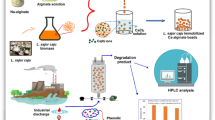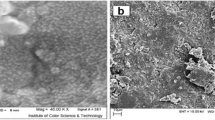Abstract
Biosorption of copper (II) and cadmium (II) by live Phanerochaete chrysosporium immobilized by growing onto polyurethane foam material in individual packed bed columns over two successive cycles of sorption–desorption were investigated in this study. Initial pH and concentrations of the metals in their respective solutions were set optimum to each of those: 4.6 and 35 mg·l−1 in case of copper and 5.3 and 11 mg·l−1 for cadmium. The breakthrough curves obtained for the two metals during sorption in both the cycles exhibited a constant pattern at various bed depths in the columns. The maximum yield of the columns in removing these metals were found to be, respectively, 57% and 43% for copper and cadmium indicating that copper biosorption by the immobilized fungus in its column was better than for cadmium. Recovery values of the sorbed copper and cadmium metals from the respective loaded columns by using 0.1 N HCl as eluant was observed to be quite high at more than 65% and 75%, respectively, at the end of desorption in both the cycles. Breakthrough models of bed-depth service time, Adams–Bohart, Wolborska, and Clark were fitted to the experimental data on sorption of copper and cadmium in the columns, and only the Clark model could fit the sorption performance of the columns well over the entire range of ratios of concentrations of effluent to influent, i.e., C/C 0 for both copper and cadmium biosorption. The kinetic coefficients of mass transfer and other suitable parameters in the system were determined by applying the experimental data at C/C 0 ratios lower than 0.5 to the other three models.










Similar content being viewed by others
Abbreviations
- C :
-
residual metal concentration, mg·l−1
- C b :
-
metal concentration at breakthrough, mg·l−1
- C ads :
-
adsorbed metal concentration, mg·l−1
- C eq :
-
residual metal concentration at equilibrium, mg·l−1
- C max :
-
maximum (equilibrium) capacity of column, mg
- C 0 :
-
initial metal concentration, mg·l−1
- k :
-
kinetic constant in bed depth service time, Adams–Bohart, and Wolborska breakthrough models, l·mg−1·min−1
- N 0 :
-
saturation concentration, mg·l−1
- Q :
-
flow rate, ml·min−1
- r :
-
coefficient of mass transfer in Clark model for breakthrough, 1·min−1
- t :
-
time, min
- t b :
-
service time to breakthrough, min
- u :
-
linear flow rate, cm·min−1
- v m :
-
migration velocity of the concentration front in Clark model for breakthrough, cm·min−1
- W :
-
metal loading into column, mg
- Y :
-
sorption yield, %
- z :
-
bed depth, cm
- β :
-
external mass transfer coefficient in Wolborska breakthrough model, 1·min−1
References
Lameiras, S., Quintelas, C., & Tavares, T. (2008). Bioresource Technology, 99, 801–806.
Tsezos, M. (2007). Advances in Materials Research, 20 & 21, 589–596.
Yesim, K., Arpa, C., Tan, S., Denizli, A., Genc, P., & Arica, M. Y. (2002). Process Biochemistry, 37, 601–610.
Volesky, B., & Holan, Z. R. (1995). Biotechnology Progress, 11, 235–250.
Kapoor, A., Viraraghavan, T., & Roy Cullimore, D. (1999). Bioresource Technology, 70, 95–104.
Ahluwalia, S. S., & Goyal, D. (2007). Microbial and plant derived biomass for removal of heavy metals from wastewater. Bioresource Technology, 98, 2243–2257.
Pradhan, S., Singh, S., & Rai, L. C. (2007). Bioresource Technology, 98, 595–601.
Gopal, M., Pakshirajan, K., & Swaminathan, T. (2002). Applied Biochemistry and Biotechnology, 102, 227–237.
Pakshirajan, K., & Swaminathan, T. (2002). In R. Devi, & N. Ashan (Eds.), Water and environmental management series pp. 1043–1052. UK: IWA Publishing.
Dias, M. A., Lacerda, I. C. A., Pimentel, P. F., de Castro, H. F., & Rosa, C. A. (2002). Letters in Applied Microbiology, 34, 46–50.
Arica, M. Y., Sharif, F. A., Alaeddinoglu, N. G., Hasaren, N., & Hasaren, V. (1993). Journal of Chemical Technology and Biotechnology (Oxford, Oxfordshire: 1986), 58, 281–285.
Chao, S., & Jian, Y. (1998). Water Research, 32, 2746–2752.
Yesim, K., Arpa, C., Tan, S., Denizli, A., Genc, P., & Arica, M. Y. (2002). Process Biochemistry, 37, 601–610.
Tsekovaa, K., & Petrov, G. (2002). Zeitschrift fuÉr Naturforschung Section C Biosciences, 57, 629–633.
Pakshirajan, K., & Swaminathan, T. (2006). Soil Sediment Contamination, 15, 187–197.
Iqbal, M., Saeed, A., & Zafar, S. I. (2007). Journal of Hazardous Materials, 148, 47–55.
Bohart, G., & Adams, E. Q. (1920). Journal of the American Chemical Society, 42, 523–544.
Thomas, A. C. (1944). Journal of the American Chemical Society, 66, 1664–1666.
Wolborska, A. (1989). Water Research, 23, 85–91.
Hutchins, R. A. (1973). Chemical Engineering Journal, 80, 133–138.
Clark, R. M. (1987). Environmental Science & Technology, 21, 573–580.
Pakshirajan, K., & Swaminathan, T. (2006). Proceedings of the fourth international symposium on southeast asian water environment (pp. 269–276). Bangkok, Thailand.
Volesky, B., Weber, J., & Park, J. M. (2003). Water Research, 37, 297–306.
Antonio, S., Ballester, A., Blazquez, M. L., Gonzalez, F., Munoz, J., & Hammaini, A. (1999). FEMS Microbiology Reviews, 23, 527–536.
Sag, Y., & Aktay, Y. (2001). Process Biochemistry, 36, 1187–1197.
Valdman, E., Erijman, L., Pessoa, F. L. P., & Leite, S. G. F. (2001). Process Biochemistry, 36, 869–873.
Fritz, J. S., & Schmitt, D. H. (1966). Talanta, 13, 123–128.
Tran, H. H., & Roddick, A. (1999). Water Research, 33, 3001–3011.
Guibal, E., Lorenzelli, R., Vincent, T., & Le Cloirec, P. (1995). Environmental Technology, 16, 101–114.
Author information
Authors and Affiliations
Corresponding author
Rights and permissions
About this article
Cite this article
Pakshirajan, K., Swaminathan, T. Biosorption of Copper and Cadmium in Packed Bed Columns with Live Immobilized Fungal Biomass of Phanerochaete chrysosporium . Appl Biochem Biotechnol 157, 159–173 (2009). https://doi.org/10.1007/s12010-008-8283-3
Received:
Accepted:
Published:
Issue Date:
DOI: https://doi.org/10.1007/s12010-008-8283-3




